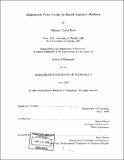| dc.contributor.advisor | Glenn Ellison. | en_US |
| dc.contributor.author | Noel, Michael David, 1971- | en_US |
| dc.contributor.other | Massachusetts Institute of Technology. Dept. of Economics. | en_US |
| dc.date.accessioned | 2005-08-23T20:01:07Z | |
| dc.date.available | 2005-08-23T20:01:07Z | |
| dc.date.copyright | 2002 | en_US |
| dc.date.issued | 2002 | en_US |
| dc.identifier.uri | http://hdl.handle.net/1721.1/8416 | |
| dc.description | Thesis (Ph.D.)--Massachusetts Institute of Technology, Dept. of Economics, 2002. | en_US |
| dc.description | Includes bibliographical references (p. 135-137). | en_US |
| dc.description.abstract | In this dissertation, I present three essays that are motivated by the interesting and dynamic price-setting behavior of firms in Canadian retail gasoline markets. In the first essay, I examine behavior at the market level for 19 Canadian cities over 574 weeks. I find three distinct pricing patterns: 1. standard cost-based pricing, 2. sticky pricing, and 3. steep, asymmetric retail price cycles that mirror the Edgeworth Cycles of Maskin & Tirole [1988b]. I use a Markov switching regression to estimate the prevalence of the regimes, the pattern of markup in each, and the structural characteristics of the price cycles themselves. Retail price cycles prevail in over 40% of the sample. I show they are more prevalent when there is a greater penetration of small, independent firms. The cycle is accelerated and amplified in markets with very many small firms. Where small firms are few, sticky pricing dominates. In the second essay, I present a new station-level micro-dataset that reveals especially strong retail price cycles in the Toronto market. I show that it is large firms who first reset each new cycle by significantly raising prices. The one-time average price increase is 5.6 cents per liter, or 170% of the average margin. The magnitude of the increase is decreasing in the previous markup and increasing in expected future wholesale prices. I show that small independent firms wait longest before responding, and the entire process is usually complete in 24 hours. From the top of the cycle, I find small firms undercut first and trigger each new round of tit-for-tat price undercutting. | en_US |
| dc.description.abstract | (cont.) In the third essay, I explore the theoretical conditions that best foster price cycles and how those conditions affect the character of the cycles themselves. Using computational techniques, I search for Markov Perfect Equilibria under several models of duopoly and triopoly and for various model-specific parameter values. I consider degrees of differentiation, capacity constraints, sharing rules, discount factors and initial beliefs about price leading behavior. I find Edgeworth price cycles with interesting characteristics under many conditions and focal prices under others. | en_US |
| dc.description.statementofresponsibility | by Michael David Noel. | en_US |
| dc.format.extent | 137 p. | en_US |
| dc.format.extent | 9070890 bytes | |
| dc.format.extent | 9070650 bytes | |
| dc.format.mimetype | application/pdf | |
| dc.format.mimetype | application/pdf | |
| dc.language.iso | eng | en_US |
| dc.publisher | Massachusetts Institute of Technology | en_US |
| dc.rights | M.I.T. theses are protected by copyright. They may be viewed from this source for any purpose, but reproduction or distribution in any format is prohibited without written permission. See provided URL for inquiries about permission. | en_US |
| dc.rights.uri | http://dspace.mit.edu/handle/1721.1/7582 | |
| dc.subject | Economics. | en_US |
| dc.title | Edgeworth price cycles in retail gasoline markets | en_US |
| dc.type | Thesis | en_US |
| dc.description.degree | Ph.D. | en_US |
| dc.contributor.department | Massachusetts Institute of Technology. Department of Economics | |
| dc.identifier.oclc | 50602161 | en_US |
